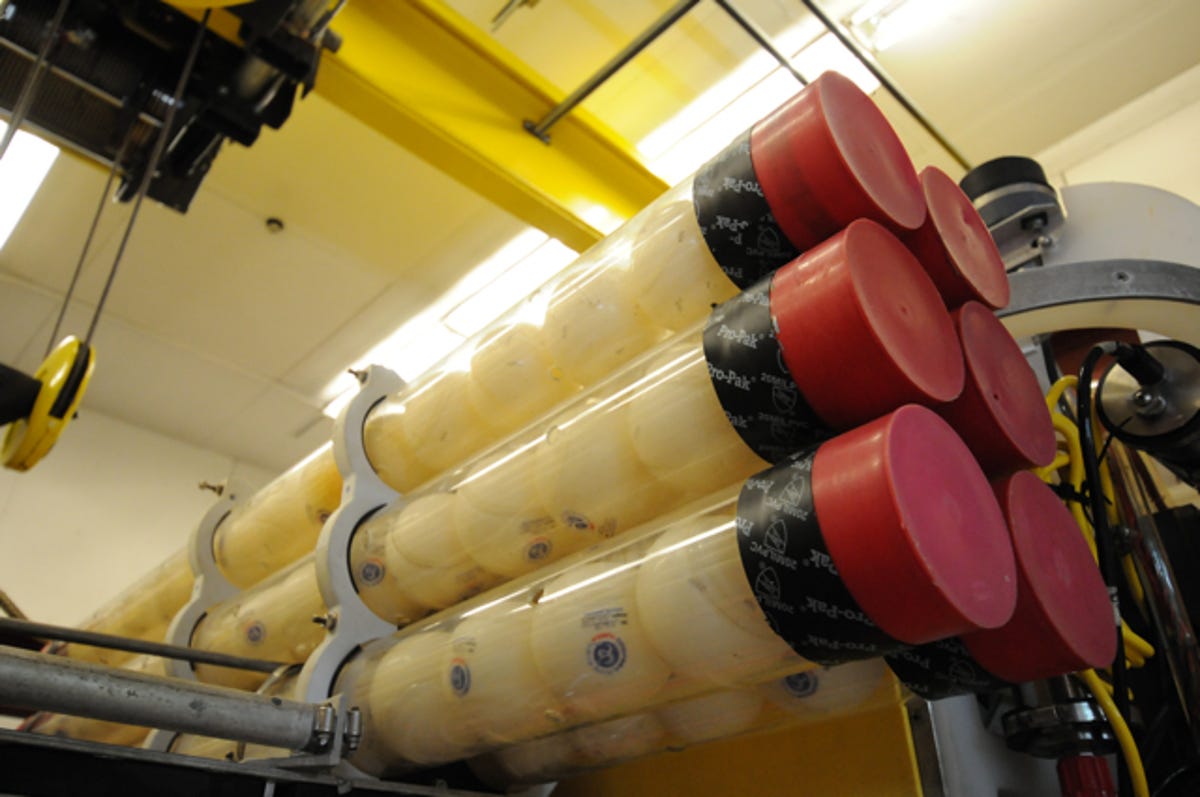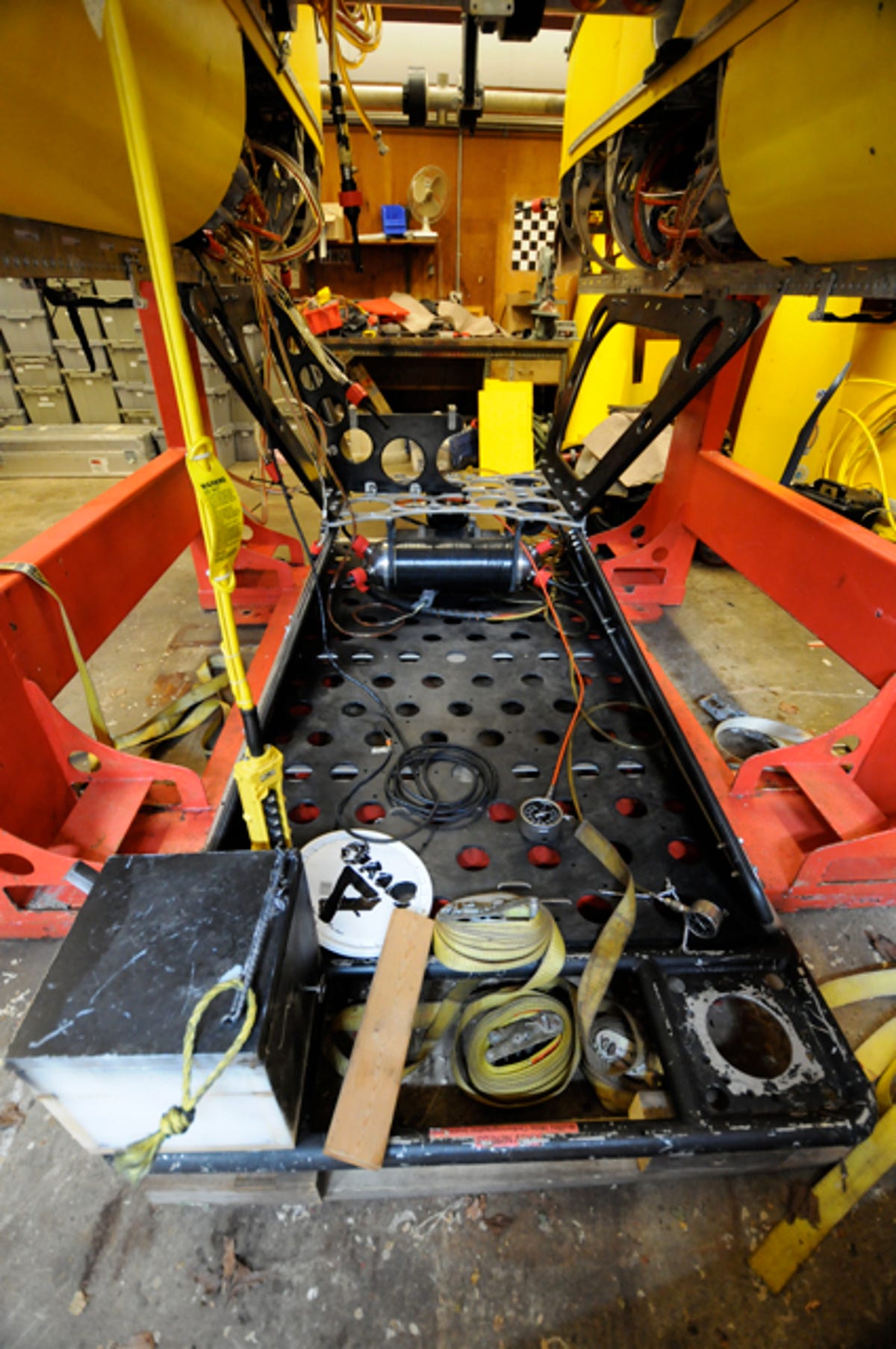The world-class deep-sea vehicles of Woods Hole (photos)
Road Trip 2010: CNET reporter Daniel Terdiman checked in to see the amazing Nereus hybrid remotely operated vehicle.

Flotation devices
WOODS HOLE, Mass.--With the BP oil spill in the news for the last three months, and the necessity of trying to plug the huge leak at a depth of a mile, the concept of doing heavy-duty deep-sea work may be more in the public's mind than it has been for years.
But at the Woods Hole Oceanographic Institute, such a focus is a full-time job, and in pursuit of solutions to the challenges that come up daily in the field of oceanography, researchers and scientists there have, over the years, developed some of the world's most leading edge systems for probing the deep.
That work focuses both on hardware systems--primarily deep-sea vehicles like autonomous underwater vehicles (AUV) or remotely operated vehicles (ROV)--and on software tools to interpret and present the data these vehicles gather.
One of the most cutting-edge tools Woods Hole has in its arsenal is the Nereus, a hybrid remotely operated vehicle that can work either as a traditional tethered ROV or as an AUV. Capable of diving more than seven miles below the surface, Nereus has the potential to change the way underwater science is done, given that it may take autonomy to a new level.
As part of Road Trip 2010, CNET reporter Daniel Terdiman visited Woods Hole and got a closeup look at Nereus.
Seen here are some of the ceramic flotation devices that dominate the rear of the vehicle.
Click here to read the related story on the research and innovations of the Woods Hole Oceanographic Institution. And click here to check out the entire Road Trip 2010 package.
Nereus on blocks
Currently not being utilized for any scientific research, Nereus sits in a small room at the Woods Hole Oceanographic Institute, where it's being prepped for an operation this fall on behalf of the Defense Advanced Research Projects Agency (DARPA) to investigate sub-sea communications networks.
Click here to read the related story on the research and innovations of the Woods Hole Oceanographic Institution. And click here to check out the entire Road Trip 2010 package.
Nereus gets wet the first time
In this December 2007 picture, taken off the Waianea coast of Oahu, in Hawaii, Nereus is being prepared for its initial deep water dive. The vessel can either work as an autonomous vehicle, following predetermined missions to map the floor of the sea and gather other ocean data, or as a tethered vehicle, thanks to more than 25 miles of very thin fiber cable that connect it to the surface ship off of which it's launched.
Click here to read the related story on the research and innovations of the Woods Hole Oceanographic Institution. And click here to check out the entire Road Trip 2010 package.
Nereus returns
Here we see Nereus being brought back onto the research ship Kilo Moana after an early test in Hawaiian waters.
Click here to read the related story on the research and innovations of the Woods Hole Oceanographic Institution. And click here to check out the entire Road Trip 2010 package.
Rear view
A rear view of Nereus, at the Woods Hole Oceanographic Institute.
Click here to read the related story on the research and innovations of the Woods Hole Oceanographic Institution. And click here to check out the entire Road Trip 2010 package.
Manipulator arm
This manipulator arm is attached to a sled that's attached to Nereus' bottom, and it can be used for any of a large number of applications that call for a nimble claw arm.
Click here to read the related story on the research and innovations of the Woods Hole Oceanographic Institution. And click here to check out the entire Road Trip 2010 package.
Manipulator arm in action
At Woods Hole Oceanographic Institute, research engineer Matt Heintz shows off the manipulator arm in action. Here it's hoisting a "push corer," which is aimed at taking ocean floor sediment samples.
Click here to read the related story on the research and innovations of the Woods Hole Oceanographic Institution. And click here to check out the entire Road Trip 2010 package.

The sled
The sled on the underside of Nereus. Among other things, this is what the manipulator arm is attached to before a mission.
Click here to read the related story on the research and innovations of the Woods Hole Oceanographic Institution. And click here to check out the entire Road Trip 2010 package.
Front
A wide-angle view of the front and side of Nereus.
Click here to read the related story on the research and innovations of the Woods Hole Oceanographic Institution. And click here to check out the entire Road Trip 2010 package.
Storage
On the rear end of Nereus' sled, this container is used to collect many of the items that need to be stored after being picked up on a mission.
Click here to read the related story on the research and innovations of the Woods Hole Oceanographic Institution. And click here to check out the entire Road Trip 2010 package.
Electronics bay
This empty space is where much of the Nereus' electronics fit when the vehicle is being readied for a launch.
Click here to read the related story on the research and innovations of the Woods Hole Oceanographic Institution. And click here to check out the entire Road Trip 2010 package.
Making SeaBED
One of the research interests of Woods Hole Oceanographic Institution associate scientist Hanumant Singh is deep water archaeology, and in 2005, Singh and a team of colleagues visited Greece, where they searched for--and found--the shipwreck of an ancient vessel lost at sea. Here, Singh (second from left) and his colleagues Neil McPhee (left), Ryan Eustice (middle), Chris Murphy (second from right), and Chris Roman (right, with back to camera) assemble the SeaBED autonomous unmanned vehicle they'll use to search Greek seas for the ancient shipwreck they'll eventually find.
Click here to read the related story on the research and innovations of the Woods Hole Oceanographic Institution. And click here to check out the entire Road Trip 2010 package.
Sonar map
Here we see a multibeam sonar map of the Chios shipwreck site in Greece. Looking much like a standard topographical map, this shows the wreck site's vertical relief.
Click here to read the related story on the research and innovations of the Woods Hole Oceanographic Institution. And click here to check out the entire Road Trip 2010 package.
Merged data
This image represents the merged data of a single photomosaic strip and the multibeam sonar bathymetry from the Greek shipwreck site. This is comprised of 34 separate mosaic images, and sonar data collected simultaneously by SeaBED during one pass over the site. All told, it took about two minutes to collect this data.
Click here to read the related story on the research and innovations of the Woods Hole Oceanographic Institution. And click here to check out the entire Road Trip 2010 package.
Reds
According to Singh, one of the biggest limitations of underwater research is the fact that color is a very different thing in the deep. That means that even the most vibrant underwater colors usually are seen in photographs as muted greens. But Woods Hole has worked on new technologies that allows scientists to see real color in photographs.
Click here to read the related story on the research and innovations of the Woods Hole Oceanographic Institution. And click here to check out the entire Road Trip 2010 package.
LEDs
Here Woods Hole research assistant Terry Hammar looks at a new LED lighting system being developed at the institution that's intended for one of several AUVs like the Nereus. The institution believes LEDs have several advantages over standard AUV lighting systems because they can be quickly turned on or off, and therefore be easily synchronized with video cameras.
Click here to read the related story on the research and innovations of the Woods Hole Oceanographic Institution. And click here to check out the entire Road Trip 2010 package.

